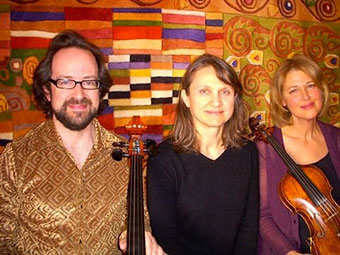Next story: How Sweet It Is
The Friends of Vienna Turns 35
by Jan Jezioro

The popular chamber music series celebrates a milestone
Back in May 2009, it looked like the Friends of Vienna Sunday afternoon chamber music series had reached the end of its tether. The few remaining organizers involved with the series had reluctantly elected to pull the plug at the end of the series’ 33rd season. Learning about the impending demise of the FOV, Mary Kunz Goldman, classical music critic for the Buffalo News, wrote an article inviting music-lovers with an interest in live performances of classical music to help prevent the end of what had become a Buffalo tradition. Soprano Mary Kay Atlas, a music teacher in the Buffalo public school system and a long-serving soloist and choir member at Holy Trinity Lutheran Church, assembled a new, working board of directors that got the FOV through the following abbreviated season, while making it a priority of the group to start sponsoring concerts in the Buffalo public schools. For its current season, the FOV expanded its series from four to six concerts while continuing its involvement with the Buffalo schools.
On Sunday, May 22, at 3:30pm, the final concert in the FOV’s season takes place in the group’s home in the Unity Church, 1243 Delaware in Buffalo, and features Jonathan Golove, cello; Claudia Hoca, piano; and Donna Lorenzo, viola, in the music of Beethoven, Schumann, and Brahms, composers whose works appear regularly on the group’s programs.
Beethoven composed his Duo for Viola and Cello “With Eyeglasses Obligato” WoO 32 in 1796, but it was not published until 1912. One of the first friends that Beethoven made after moving to Vienna was Baron Nikolaus Zmeskall von Domanovecz, secretary in the Hungarian Chancellery and a skilled amateur cellist. They quickly became close friends for life, and from many references in Beethoven’s letters, it appeared that the composer liked to tease his friend, referring to him as “Most excellent Count of Music,” or “Baron (and still bachelor).” In one letter, Beethoven, who played the viola, wrote, “I am most obliged for the weakness of your eyes,” an apparent reference to Zemskall’s short-sightedness, so it’s possible that he composed this humorously titled work to be played by himself and his friend. While the work is incomplete, the playful first movement is followed by a gentle minuet, and for this performance, ends with a transcription of Beethoven’s Organ Fugue in D Major.
Schumann composed his Stücke im Volkston, Op. 102 (“Pieces in the Popular Style”), for cello and piano, in 1849. This cycle of five poetic miniatures is characterized by a delightful melodic flexibility, achieved by the fluid passing of brief ideas from one instrument to the other. The metric irregularities of the highly colorful brief pieces have been described as “a means of imparting to the music the character of a spoken utterance.”
Rather unusually for this series, a newly composed work is also on the program: Kreisler’s Coat by cellist Jonathan Golove. About his new work, Golove writes: “Schumann based his Kreisleriana, a collection of eight short ‘fantasies’ for solo piano, on the character Johannes Kreisler, who appears in a number of E. T. A. Hoffmann’s fictional writings. Hoffmann described Kreisler as a ‘little man in a coat the color of C sharp minor with an E major colored collar.’ I took Schumann’s work as the starting point for my own, at the same time making a further association with a musico-historical figure bearing the Kreisler name, namely Fritz Kreisler, whose violin tone has always evoked for me images of golden colors and sensations of warmth.”
Following the deaths of several family members and friends, Johannes Brahms had decided to give up composing in 1890 at the relatively early age of 57, going so far as to destroy his unfinished works. Inspired by a performance of clarinetist Richard Mühlfeld in 1891, Brahms was motivated to once again start composing, writing four of his greatest chamber works: the Clarinet Trio, Op. 114, the Clarinet Quintet, Op.115, and the two Sonatas for Clarinet and Piano, Op. 120, for Mühlfeld. The clarinet part in all of these works was later transcribed for the viola, Brahms’ other favorite instrument, by the composer himself. While the Sonatas for Clarinet and Piano have become a staple of every viola soloist, the viola versions of the Trio and the Quintet versions rarely appear on concert programs. Since the great violin virtuoso Joseph Joachim was willing to take the viola part in a performance of the Trio, along with Brahms himself at the keyboard, the relative neglect of the viola version is hard to explain, but music lovers who attend Sunday’s performance will be able to make their own decision about the relative merits of the two versions.
In celebration of the end of the 35th season, a wine and cheese, meet-the-artists reception will follow the concert. Tickets are $8 general admission, $6 for students. For more information, visit www.friendsofvienna.org.
blog comments powered by Disqus|
Issue Navigation> Issue Index > v10n20 (week of Thursday, May 19) > The Friends of Vienna Turns 35 This Week's Issue • Artvoice Daily • Artvoice TV • Events Calendar • Classifieds |









 Current Issue
Current Issue